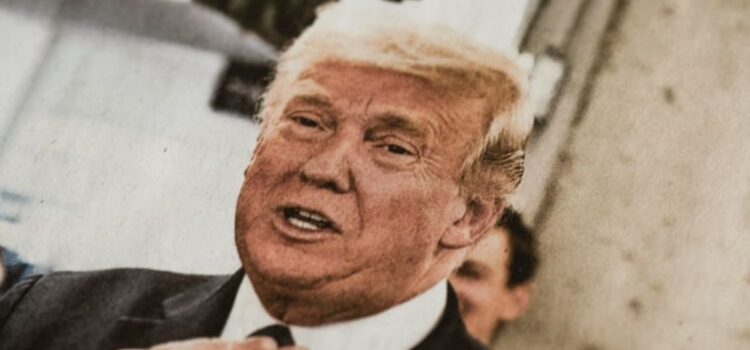

This article is an excerpt from the Shortform book guide to "A Warning" by Anonymous. Shortform has the world's best summaries and analyses of books you should be reading.
Like this article? Sign up for a free trial here .
What is A Warning about? Who is the anonymous author behind the controversial bestseller?
In the 2019 bestseller A Warning, the author discusses the behind-the-scenes of Donald Trump’s presidency. The book is written anonymously in hopes of keeping the focus on the message rather than on attacking the messenger, although “Anonymous” doesn’t rule out revealing his or her identity at some point in the future.
Here is a brief overview of A Warning by Anonymous.
A Warning: Book Summary
A Warning by “Anonymous,“ a senior Trump administration official, provides an insider’s view of three years in a turbulent administration, where aides have tried to deter President Donald J. Trump from making disastrous decisions and to mitigate the fallout when they’re unable to stop him.
Published in November 2019, the book is a followup to the author’s New York Times op-ed column, also published anonymously, on September 5, 2018, chronicling the efforts of “The Resistance,” a group of senior White House aides who worked to keep Trump from implementing reckless, petty, or illegal decisions. The op-ed piece was meant to assure Americans that there were “adults in the room,” who were working behind the scenes to protect the country’s interests from an immoral president, who put self-interest first.
However, the book argues that the resistance effort didn’t work—subsequently, the “guard rails” have come off. Trump has fired or driven away nearly every principled advisor, and he is running amok, like a twelve-year-old indiscriminately pushing buttons in an air traffic control tower. The author argues that Trump is unfit to be commander in chief and the nation must “fire” him before he destroys our democratic system.
The Steady State Fails
Trump’s principled advisors thought of themselves as a Steady State, keeping the presidency on track, as opposed to Trump’s imagined Deep State, which he claims is secretly undermining his presidency. However, on December 19, 2018, the firewall failed and Trump made a reckless foreign policy decision. It signaled the beginning of the end for the pragmatists in the White House, who thought they could contain him.
In this incident, Trump suddenly tweeted that the U.S. had defeated ISIS in Syria and he was withdrawing U.S. troops there. However, administration officials had just testified in Congress that ISIS remained a threat and had pledged not to leave Syria. Trump’s announcement alarmed and confused allies, hung the Defense Department out to dry, and raised concern about the safety of troops on the ground. Secretary of Defense Jim Mattis resigned the next day.
It shattered the illusions of those who still thought they could bring discipline to a chaotic administration. The Steady Staters ultimately found Trump to be “unfit for the job” because:
- He couldn’t focus on governing,
- He sought to abuse his power through half-baked schemes to punish political opponents.
- He constantly undermined democratic principles and institutions.
Dysfunctional White House
From the beginning, Trump’s impulsiveness and inattention defied any attempts to create order. His demands of aides typically fell into one of three categories: dumb, impossible, or illegal.
Staff referred to the process of dealing with a sudden Trump impulse to do something rash as a “five-alarm fire drill.” The scenario often started with Trump seeing something on television that bothered him and having a knee-jerk reaction—for instance, deciding to fire the Federal Reserve chairman. If staff received even a small amount of notice, they would rush to mobilize an effort to influence his views before he tweeted them out. This process of decision-making became the norm and was so exhausting for aides that they’d schedule frivolous campaign rallies to get Trump out of town.
Trump’s inattention was another problem. He wouldn’t read long papers or even summaries. Briefers learned to reduce their messages to a single point and keep repeating it, even when Trump veered off on another topic. If a briefer didn’t keep things short and sweet, Trump was likely to shout, “What the f-ck,” and throw the papers at the presenter.
Trump had no interest in or ability to manage daily functions of government. He couldn’t lead because he didn’t understand how the executive branch worked. Departments and agencies were confused about what to do and who was in charge. Policies weren’t thought out or coordinated; issues were ignored until they reached a crisis point.
Adding to the chaos, Trump liked to keep officials on edge by commenting publicly on their job performance or fueling gossip by complaining about someone. White House officials were perpetually on “deathwatch,” waiting to be fired by presidential tweet.
Until Trump ousted him, Chief of Staff John Kelly managed to rein in some of the president’s ad hoc decision-making. However, trying to improve the process was just applying a Band-Aid. Changing the system couldn’t fix Trump.
Waging War on Democracy
The United States has a system of checks and balances, based on three co-equal branches of government, to deter presidential abuses of power. The Trump presidency has proven to be one of the system’s biggest tests. Trump has undermined and attacked all three branches:
- Intelligence community: Trump began attacking the intelligence community even before taking office for its conclusion that Russians were interfering in the election campaign to benefit him. He’s continued to ridicule intelligence assessments and refused briefings because he’s “smart” and doesn’t need them. In addition, he’s sought to politicize intelligence information, retaliating against intelligence officials who contradict him. He’s also mishandled sensitive information, potentially putting agents’ lives in danger.
- Courts: Trump has regularly attacked judges. For instance, he blasted an immigration ruling against his administration and attacked the judge, suggesting he was unfair and the court should be investigated. Trump also demanded that aides draw up a bill to cut the number of federal judges and send it to Congress, but they ignored it.
- Investigators: Trump has pressured those investigating him, both privately and publicly. He fired FBI Director James Comey in May 2017, in an apparent effort to protect himself from investigation. He undermined special counsel Robert Mueller’s Russia investigation and tried to get White House officials to fire him as well.
- Lawyers: He tries to force White House lawyers to say what he wants to hear, pushing them to the edge of what’s legal until they go beyond it, setting the administration up for a fall. He’s sought ways to use the White House and federal investigators to punish his political opponents, especially the Clintons.
- Congress: Although it’s Congress’s role to act as a check on the president, Trump finds it intolerable that congressional committees have the authority to oversee federal agencies. Besides denigrating individual members on Twitter, he’s told appointees to defy rules that require them to work with Congress, such as giving Congress advance notification of arms sales. In addition, Trump has actively impeded congressional inquiries, instructing lawyers and appointees to ignore subpoenas.
Members of the Steady State learned that Trump would abuse any power at his disposal: “No external force can ameliorate his attraction to wrongdoing. His presidency is continually jeopardized by it, and so are America’s institutions.”
Praising Dictators, Blasting Allies
Trump has “flipped the script” on American foreign policy by cozying up to enemies and distancing us from our friends.
For example:
- After the brutal murder by Saudi hitmen of Washington Post columnist Jamal Khashoggi in 2018, Trump refused to criticize crown prince Mohammed bin Salman, although the evidence indicated he was behind it. “I want to stick with an ally that in many ways has been very good,” Trump said.
- Trump admired the way North Korean dictator Kim Jong Un ascended to power and desperately wanted to make a deal with him. When Kim indicated he wanted to meet, Trump agreed immediately despite concerns among his advisors. The summit didn’t produce anything meaningful, yet Trump considered it a great success. He described the talks this way: “We went back and forth, then we fell in love.”
While flattering dictators, Trump has no qualms about alienating our closest allies and personally insulting their leaders, whom he claims are taking advantage of U.S. assistance. Besides his insults, Trump is damaging these important relationships with threats and punitive actions. For instance,
- He’s imposed trade penalties, invoking “national security.”
- He threatened to discard a defense treaty with Japan.
- He regularly threatens to withdraw from agreements to get partners to do what he wants, including showing loyalty to him.
Contrary to what Trump says, our allies aren’t taking advantage of us. And we need them. Unfortunately, however, they no longer trust us. Many are planning to either live without us or deal with us as a rival.
Divisiveness and Lies
By using his soapbox to sow division, insult, and animosity, Trump has eroded our national conversation. His words migrate from his tweets to people’s conversations at home and at work. According to a Pew Research survey, a majority believes that Trump has changed the tone of our national discourse for the worse.
A worse trait than Trump’s desire to divide people is his dishonesty. He makes wild claims and spreads conspiracy theories and clearly false information—for instance, insisting that millions of people voted illegally in the 2016 presidential election. While some dismiss this as just his style, too many others believe whatever he says because he’s the president.
Trump is distorting our perceptions of truth. To Trump, there’s no objective truth. If people believe something, then it’s true. “A tree is only a tree to him if we all agree it’s a tree. If he can convince us it’s a sheep, then it is a sheep.”
It’s increasingly difficult for citizens to find common ground because they can’t agree on what’s true. We can’t solve problems when we can’t agree on the facts about the problems. Lies that are repeated often enough gradually change public perceptions of what’s true. This can create chaos in a free society. When we’ve lost our ability to reason and separate truth from falsehoods, we’ll have no defense against authoritarianism and other threats to democracy.
Our last hope for truth and our bulwark protecting democracy is a free press—which Trump also is working relentlessly to undermine in an all-out battle against journalists.
Apologists
During the 2016 campaign, Republican leaders were nearly united in their assessment of Trump as unfit to be commander in chief. However, today a majority are Trump apologists, who enable him to the detriment of the country and their party.
Trump has two kinds of apologists:
1) The sycophant: This person is a “true believer,” who fell instantly for Trump and demonstrates admiration by buying anything with Trump’s name on it, whether it’s Trump Stakes or Trump Vodka. They eat up his talking points, slurs, and denigration of opponents. They’re driven by a desire for power and by tribalism.
2) The silent abettor: This person knows that what’s going on in the Trump administration is wrong, but doesn’t say anything. Silent abettors are motivated by the desire for power and by fear, having subordinated their principles to self-interest.
It’s disheartening how many on Trump’s staff and in the Republican Party are staying silent when their voices are so urgently needed. This applies especially to members of Congress, who have a constitutional duty to scrutinize the president and the executive branch. Unfortunately, Republican members haven’t stepped up to criticize Trump when he deserves it. If they can’t applaud him, they go silent.
Firing Trump
There’s no doubt about the verdict on Donald Trump. Despite a number of accomplishments, Trump is:
- Acting immorally
- Attacking Democratic institutions
- Deserting vital U.S. allies and emboldening enemies and rivals
- Dividing Americans with hateful rhetoric and incessant lies
Roman statesman Cicero identified four moral qualities that define a leader of character. On every count, Trump fails:
1) Wisdom: Trump believes and spreads false information.
2) Justice: He’s unfair and dishonest in his dealings with others.
3) Courage: Trump blames others for his failures.
4) Temperance: He’s immoderate in nearly everything.
The Steady State can’t fix the situation. The question is how to remove him from office. There are three options:
1) Invoking the Twenty-Fifth Amendment: Under the amendment, if Vice President Mike Pence and a majority of the cabinet believed Trump couldn’t perform his duties, they could remove him. However, there’s a grave downside, which is why the option “wasn’t seriously contemplated” by the Steady State: It would be viewed as a coup and create civil unrest.
2) Impeachment: As this book was written, an impeachment inquiry was underway into whether the president abused his power for political ends and obstructed justice. However, no one should take joy in it. Rather than hoping Trump is guilty and wishing further division on the country, we should allow the process to play out, following the facts where they lead. Democrats shouldn’t rush to judgment and Republicans shouldn’t try to block justice.
3) Electoral defeat: Ultimately, elections are the best way to keep leaders in check. Let voters examine Trump’s performance and decide whether he’s fit for the office and whether his conduct reflects the nation’s values.
The consequences of reelecting Trump couldn’t be more dire. His administration is a catastrophe, the result of his weak morals. Any accomplishments are far outweighed by the damage he’s done to the nation. Another four years could very well sink the ship.
Fortunately, candidates more honorable (and stable) than Trump have stepped up. Hopefully, additional candidates who appeal to a broad spectrum of voters in our polarized political climate will join them. Much remains up in the air, but the most important thing is that we not be afraid to make a change.

———End of Preview———
Like what you just read? Read the rest of the world's best book summary and analysis of Anonymous's "A Warning" at Shortform .
Here's what you'll find in our full A Warning summary :
- An inside look at the chaotic Trump administration written by a senior Trump administration official
- An examination of Trump's authoritarianism and threats to democracy
- The three options that existed for removing Trump from office






